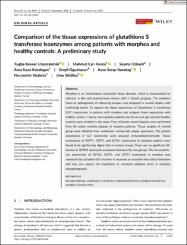Comparison of the tissue expressions of glutathione S transferase isoenzymes among patients with morphea and healthy controls: A preliminary study

View/
Date
2020Author
Uzunçakmak, Tuğba KevserKoska, Mahmut Can
Özkanlı, Şeyma
Kaya Koçdoğan, Arzu
Oğuztüzün, Serpil
Karadağ, Ayşe Serap
Akdeniz, Necmettin
Wollina, Uwe
Metadata
Show full item recordAbstract
Morphea is an inflammatory connective tissue disorder, which is characterized by
sclerosis in skin and subcutaneous tissues with a chronic progress. The oxidative
stress in pathogenesis of sclerosing diseases was proposed in several studies with
conflicting results. To explore the tissue expressions of Glutathione S transferase
(GST) isoenzymes in patients with morphea and compare these expressions with
healthy controls. Twenty-two morphea patients and 20 sex and age matched healthy
controls were enrolled in this study. Four millimeter punch biopsies were performed
from the active sclerotic plaques of morphea patients. Tissue samples of control
group were obtained from nonlesional normal skin biopsy specimens. The protein
expressions of GST isoenzymes were analyzed immunohistochemically. Tissue
expressions of GSTP1, GSTT1, and GSTA1 isoenzymes in morphea patients were
found to be significantly higher than in control tissues. There was no significant difference in GSTM1 isoenzyme expression between the two groups. The increased tissue expressions of GSTA1, GSTP1, and GSTT1 isoenzymes in morphea may
represent the activated GST enzymes in response to excessive free radical formation
and may also support the hypothesis of increased oxidative stress in morphea
etiopathogenesis.
Volume
33Issue
6Collections
The following license files are associated with this item:

















